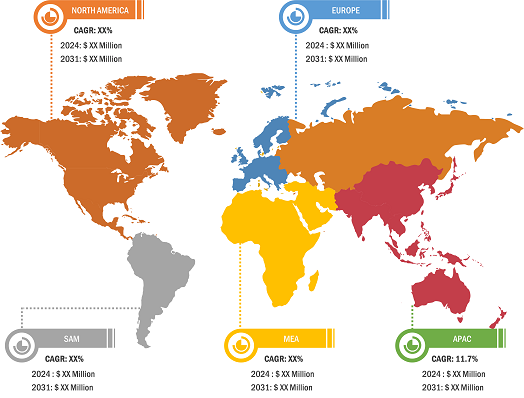Growing Consumer Demand for Security and Convenience Boost Home Automation Market Growth
According to our latest study titled “Home Automation Market Forecast to 2031 – Global and Regional Share, Trend, and Growth Opportunity Analysis – by Product and Networking,” the market was valued at US$ 89.11 billion in 2024 and is projected to reach US$ 183.80 billion by 2031; it is estimated to register a CAGR of 11.2% during 2025–2031. The report includes growth prospects in light of current home automation market trends and factors influencing the market growth.
The growing consumer preference for improved security and convenience is evident. Advancements in technology and the rise of new technology choices have led to increased options for security in the way of smart home solutions. From AI devices with smart locks, video surveillance to real-time alerts, notification and remote access to the status of their home with a smartphone or voice assistant device, consumers are looking for reliable security solutions. Increasing concern of home security, along with the shift in lifestyle preferences for automation to provide ease of life through consumer automation, affect consumers' decision making. For example; smart door locks allow users to use AI to eliminate false alarms due to recognition capabilities for familiar faces versus strangers.
Home Automation Market – by Region, 2024 and 2031
Home Automation Market Size and Forecast (2021 - 2031), Global and Regional Share, Trend, and Growth Opportunity Analysis Report Coverage : By Product (Security and Access Control, Lighting Control, Climate Control, Entertainment Centers, and Outdoor Automation Systems), Networking (Wireless, Wired and Power-Line)
Home Automation Market Report | Size, Share & Growth 2031
Download Free Sample
Source: The Insight Partners Analysis
Convenience is equally influential to consumers decision making process. As consumers become comfortable with voice assistants (Amazon Alexa, Google Assistant, Apple Siri) to control lighting, heating, entertainment, appliances, etc., it is easier to interact and create the home environment that fits the user's exact preferences queuing all kinds of activities into one seamless experience. Setting automation routines for lights and climate control as the occupants arrive home or go to sleep improves comfort while reducing energy use for the sake of sustainability and accommodations for hectic schedules. Since virtually all the features can be controlled remotely, consumers can optimize the management of their homes, facilitating the adoption of smart home solutions by convenient remote access as an expected benefit.
Instances of impactful adoption include urban markets such as the UAE and the US, where tech-savvy populations increasingly deploy advanced home security systems integrated with AI and cloud analytics, reflecting a confluence of security and convenience demands. These systems provide real-time notifications and intelligent automation, significantly elevating perceived value and satisfaction. Industry leaders, including Samsung and Schneider Electric, promote integrated security and convenience solutions, emphasizing interoperability and user-friendly control interfaces. This growing consumer appetite for smarter, safer, and more efficient homes directly contributes to expanding market demand and continuous innovation in home automation technologies. This is contributing tho the home automation market size.
The home automation market analysis has been carried out by considering the following segments: Product and Networking. In terms of product, the home automation market is segmented into entertainment centers, security and access control, lighting control, climate control, outdoor automation systems, and others. Based on networking, the home automation market is divided into wired and wireless. The wireless segment held the largest home automation market share in 2024.
The geographic scope of the home automation market report is primarily segmented into North America (the US, Canada, and Mexico), Europe (Russia, the UK, Germany, France, Italy, and the Rest of Europe), Asia Pacific (South Korea, China, India, Japan, Australia, and the Rest of Asia Pacific), Middle East & Africa (the UAE, Saudi Arabia, South Africa, and the Rest of Middle East & Africa), and South & Central America (Brazil, Argentina, and the Rest of South & Central America). North America accounted for the largest home automation market share in 2024. The home automation market in North America is segmented into the US, Canada, and Mexico. North America is a global leader in the home automation market, driven by high technology adoption, a strong smart home ecosystem, and consumer interest in convenience, energy efficiency, and security. The presence of key players such as Google, Amazon, and Apple has helped normalize smart devices in everyday life. Integration with voice assistants such as Alexa, Siri, and Google Assistant has simplified the user experience, encouraging adoption across various demographics.
Consumers in the US and Canada increasingly embrace connected devices, from smart thermostats and lighting systems to security cameras and connected appliances. Demand is also rising for whole-home integration platforms that allow centralized control via mobile apps or voice commands. The growing awareness of energy conservation and incentives for energy-efficient upgrades is prompting more homeowners to invest in smart heating and cooling systems.
Siemens AG; Lutron Electronics Co., Inc; Johnson Controls International Plc; Honeywell International Inc; Legrand SA; ABB Ltd; Schneider Electric SE; Robert Bosch GmbH; Crestron Electronics, Inc.; and Leviton Manufacturing Co., Inc. are among the key players profiled in the Home Automation market report.
Contact Us
Phone: +1-646-491-9876
Email Id: sales@theinsightpartners.com